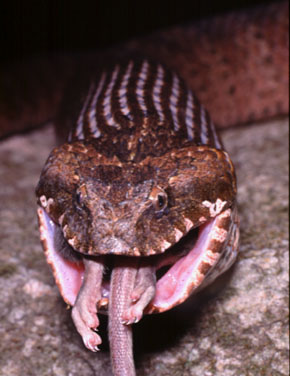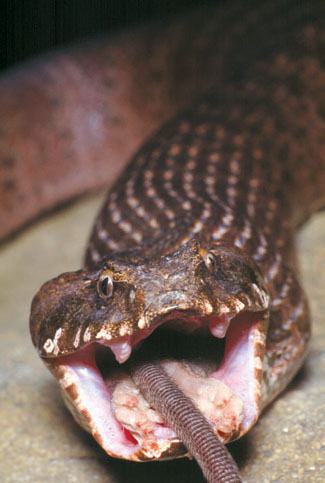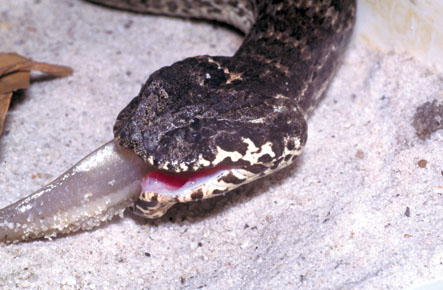|
NOTES ON FEEDING CAPTIVE DEATH ADDERS (ACANTHOPHIS ANTARCTICUS), INCLUDING POSTURING BEHAVIOUR IN RESPONSE TO LARGE FOOD ITEMS.
|
Originally published in 2003 in Herpetofauna 33(1):16-17.
Raymond Hoser
488 Park Road Park Orchards, Victoria, 3114, Australia.
E-mail: adder@smuggled.com
 In 2002, I had difficulty in obtaining rodent food for some young captive-bred death adders from the Blue Mountains in New South Wales. As a result the snakes were fed unusually large mice, relative to the size of the snakes. Certain observations made in relation to these and other feedings are reported here.
In 2002, I had difficulty in obtaining rodent food for some young captive-bred death adders from the Blue Mountains in New South Wales. As a result the snakes were fed unusually large mice, relative to the size of the snakes. Certain observations made in relation to these and other feedings are reported here.
TRAINING YOUNG SNAKES TO FEEDING ON MICE
Next to nothing would stop these snakes from attempting to feed on mice of any size. It appears that with this species at least, once a snake commences feeding on a prey item, it will continue to do so, regardless of size and even when the item is clearly too large for the snake to digest and/or would cause great discomfort if consumed. This appears to be an instinctive response and not restricted to snakes in captivity, as Hoser (1981) reported a wild-caught death adder that had eaten a water dragon (Physignathus lesueurii) too large to digest, and which died when unable to regurgitate the lizard.
This trait can also be used to a keeper's advantage. As a matter of course pre-killed food is the food of choice by many keepers, including myself. Some small death adders are finicky or difficult to feed in captivity, and display a preference for skinks over mice. Young death adders that take skinks can usually be encouraged to "follow-on" to a mouse as they continue to swallow the posterior part of the skink. This can done by placing the head of the mouse into the snake's mouth (with tongs) and the snake continues swallowing this next item. Merely placing the mouse's head immediately adjacent to the snake's mouth and lizard's tail will usually see the snake continue the feeding motion over the mouse.
This trait is one of several means that can be used to switch a difficult snake over to rodents. The next step in switching the snake to mice is usually to tease a hungry snake with a skink before quickly swapping it with a mouse and having the snake strike at and eat the latter item.
Another variant is the use of cotton to tie a mouse to a lizard and feed the pair to a snake. However in this case, one must usually ensure that the mouse's head is taken on the first bite and hence it is not my preferred method.
 Losses of young Death Adders
Losses of young Death Adders
Based on conversations with reptile keepers, young death adders held by inexperienced keepers frequently die. Notwithstanding this, there remain many keepers (including myself) who have almost no mortality in their young death adders. Thus some key pointers to success are worth noting.
Death adders like heat and failure to provide enough heat in the cage can give rise to many problems. A temperature gradient is essential to allow the snake to thermoregulate as necessary. Failure to provide sufficient heat is the most common cause of regurgitation and ultimate death in young death adders. This is particularly so if the snake eats unusually large items.
If one is to feed oversized items to a snake it is best not to do so after prolonged fasting. It is better to precede by a day or two with a smaller feed, which appears to get the digestive system into operation at greater speed.
Water is essential to these snakes and a water bowl should be provided. Death adders are quite capable of finding this water and drinking as necessary, contrary to rumours that they are unable to drink and/or only drink when sprayed. Spraying is not necessary for successful husbandry, and although doing this may make the snakes perk up and become more active for a short time, it makes the cages too damp and humid, and this may lead to other problems.
Excluding complications caused by over-feeding and/or lack of sufficient heat for digestion purposes and general health, the most common killer of death adders in captivity is mite infestations or complications arising from them. I use pest strips to kill the mites and have never had pest-strip induced complications, although as with any toxic substance, pest strips should be used with care.
Young snakes should be fed soon after the first slough, avoiding a general weakening of the animal and increased susceptibility to disease. Young snakes need to eat a lot to maintain growth. In the event that a young snake does not take food voluntarily, assist or even force-feeding young snakes may be necessary to avoid loss of condition. These snakes invariably grow normally and without complication and as a rule, will begin to take food as offered within six months.
 Anti-regurgitation tactics by Death Adders
Anti-regurgitation tactics by Death Adders
When they have fed, death adders (like other snakes) seek warmth to facilitate digestion. When unusually large items have been consumed, this is even more important. When the food is not digested within a relatively short time, the item may decompose and become toxic leading to regurgitation. This may kill an unhealthy snake, but a healthy snake will usually survive a regurgitation ordeal without any significant long-term damage and be ready to feed again within a few days.
In one case a mouse of similar weight to a young death adder was retained and digested. In three other similar cases, this did not happen, with the mouse being regurgitated. Regurgitation usually occurred from 36 to 84 hours after feeding.
After these incidents, I decided against using such extremely large food relative to body size. However, some large mice (relative to the snakes) were still fed to them and in all cases the snakes engaged in a similar behaviour pattern that was clearly designed to aid digestion and prevent regurgitation.
In addition to seeking out warmth, these snakes drank considerable amounts of water and positioned themselves in an unusual resting position, with the neck region having a strong and distinct kink in it. The kink possibly prevented reflux of digestive fluids to the upper oesophagus and held the food in the lower oesophagus or stomach. This pose was retained until digestion had progressed beyond the stage where the food eaten produced a large fluid filled lump in the mid or even fore-body (the latter reflecting the oversize nature of the food eaten).
I am not aware of any previous reports of this kinking of the neck in response to digestion of oversize food in snakes of any species.
ACKNOWLEDGMENTS
Alex Stazweski of Blacktown, NSW, provided the snakes referred to in this paper. The National Parks and Wildlife Service of NSW and the Victorian Department of Natural Resources provided the relevant permits.
REFERENCE
Hoser R.T. 1981. Note on an unsuitable food item taken by a Death Adder (Acanthophis antarcticus)(Shaw). Herpetofauna 13(1): 31.
To see the exact cages used by Hoser for his Death Adders. 
Click here to download and view a 3.3 mb mpg (video) file of two mating Sydney Death Adders.
A major 1995 paper on Death Adders.
Death Adders (Genus
Acanthophis): An overview, including descriptions of five new species and one subspecies An 11,000 word paper
in Monitor - Journal of the Victorian Herpetological Society published
in April 1998.
Death Adders (Genus
Acanthophis): An updated overview, including descriptions of three new species and two subspecies. A 2002 paper published in Crocodilian - Journal of the Victorian Association of Amateur Herpetologists.
Death Adders - Red-grey colour genetics and ramifications in terms of wild populations (1985 paper)
Death Adders - Mating behaviour in captivity (1983 paper)
Death Adders - Breeding in captivity (1987 paper)
Death Adders - Overeating in the wild (1981 paper)
Death Adders - Feeding in captivity (2003 paper)
Death Adders - Colour change in captivity (1985 paper)
Death Adders - Colour change in captivity (1999 paper)
Death Adders - Colour change in captivity (1999 paper)
Virus warning - Death Adders and other Australian snakes (2003) - mortality in neonate Death Adders and other venomous snakes.
Death Adders (and other snakes) - Frequency of sloughing in captivity (1985 paper)
For numerous other papers that deal dominantly or substantially with Death Adders (Acanthophis spp.).